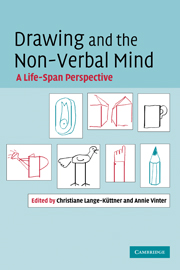Book contents
- Frontmatter
- Contents
- Contributors
- 1 Contemporary enquiries into a long-standing domain: Drawing research
- Part I Self, symbols and intention
- Part 2 Syntax, space systems and projection
- 7 The interaction of biomechanical and cognitive constraints in the production of children's drawing
- 8 Graphic syntax and representational development
- 9 Spatial structures in children's drawings: how do they develop?
- 10 Figures in and out of context: absent, simple, complex and halved spatial fields
- 11 Spatial and symbolic codes in the development of three-dimensional graphic representation
- 12 On contours seen and contours drawn
- Part III Aging, blindness and autism
- Index
- References
9 - Spatial structures in children's drawings: how do they develop?
Published online by Cambridge University Press: 22 September 2009
- Frontmatter
- Contents
- Contributors
- 1 Contemporary enquiries into a long-standing domain: Drawing research
- Part I Self, symbols and intention
- Part 2 Syntax, space systems and projection
- 7 The interaction of biomechanical and cognitive constraints in the production of children's drawing
- 8 Graphic syntax and representational development
- 9 Spatial structures in children's drawings: how do they develop?
- 10 Figures in and out of context: absent, simple, complex and halved spatial fields
- 11 Spatial and symbolic codes in the development of three-dimensional graphic representation
- 12 On contours seen and contours drawn
- Part III Aging, blindness and autism
- Index
- References
Summary
Morra uses a neo-Piagetian approach to conceptualize the development of spatial organization in children's drawings, which also includes some aspects of transition from intellectual to visual realism. He assumes the existence of graphic figurative schemes, i.e. the child's mental representations of satisfactory graphic denotations of objects, and operative schemes, i.e. procedures to modify or organize the figurative schemes. Furthermore, more general information-processing mechanisms silently affect and control the processing of these basic schemes. In particular, the F-operator (field factor) would aim for the most simple solution with the largest set of activated schemes, i.e. the F-operator is responsible for an economical solution. However, there is no accuracy implied; the F-operator can organize according to a distorting bias as much as according to a Good Gestalt or a composition law. The M-operator (mental energy factor) conceptualizes the more general information-processing capacity, with increases with age by one unit with every second year, while other factors such as the I-operator (inhibit or interrupt factor) and other learning, planning and executive factors contribute to weigh the information. Morra illustrates the neo-Piagetian approach with an analysis of the transparency phenomenon and the task of drawing a partly occluded object. Then, he uses that approach to conceptualize other developmental phenomena, such as drawing flexibility and the acquisition of a spatial axes system, in terms of informational units as well as processes, and explains how the limitation, especially in M-capacity, limits possible solutions.
objects exist in space and have a spatial structure.
- Type
- Chapter
- Information
- Drawing and the Non-Verbal MindA Life-Span Perspective, pp. 159 - 194Publisher: Cambridge University PressPrint publication year: 2008
References
- 7
- Cited by



